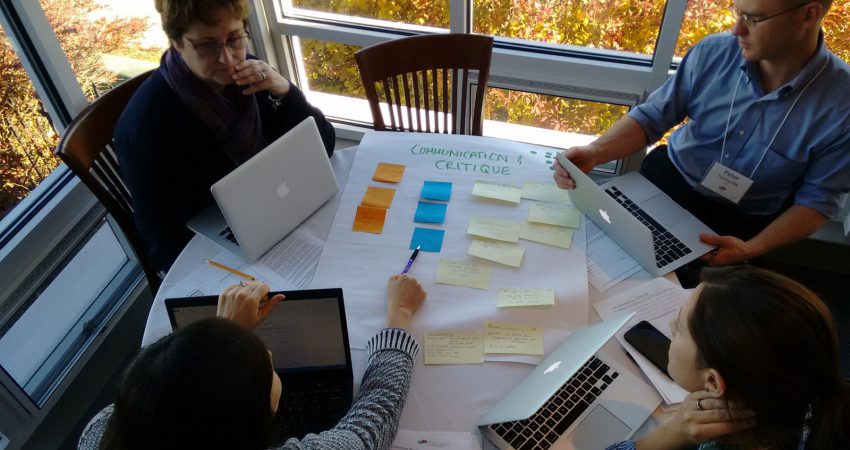
By Heather King - May 2014
PAPER CITATION
Brand, B. R. & Moore, S. J. (2011). Enhancing teachers’ application of inquiry-based strategies using a constructivist sociocultural professional development model. International Journal of Science Education, 33(7), 889–913. doi:10.1080/09500691003739374
This paper reports on a two-year schoolwide professional development (PD) initiative designed to enhance teachers’ pedagogical skills in inquiry-based science instruction.
Research Design
Thirty K–5 teachers from a rural elementary school in the U.S. participated in PD activities facilitated by university faculty. In the first year, the teachers initially engaged in a two-week inquiry-based workshop. Then they participated in regular whole-group discussions and planning meetings to design an inquiry curriculum for their students. In the second year, they implemented the curriculum, making revisions as necessary. The goal was to design a PD environment that provided ample exposure to the practices and processes of inquiry, including ongoing opportunities for reflection and the exchange of new ideas with peers.
The authors interviewed the teachers at several points during the programme in order to track any change in their beliefs about inquiry-based instruction. In addition, the teachers completed a mind map at the beginning of the initial two-week inquiry workshop and added to it three times: at the end of the workshop and again at the mid-point and end of the first year. Each addition to the map was made in a different colour so that the researchers—and the teachers themselves—could track developments in teachers’ understanding.
Research Findings
From the interviews and mind maps, three broad themes in the interview and mind map data emerged,. The incidence of these themes generally correlates with the teachers’ progress in the PD programme and can be summarised as follows:
- Acknowledging prior experiences
- Adapting and adopting inquiry-based approaches
- practice and noting improvements
The first theme refers to opportunities to exchange ideas about prior experiences, perceived constraints to practice, and existing conceptions of inquiry-based teaching. Fears about falling short of local and federal mandates were acknowledged, as were fears about losing control of the classroom.
The second theme refers to the ways teachers adapted their conceptions of inquiry-based learning and adopted student-centred approaches.
Finally, the third theme involves the teachers’ sharing of experiences and discussion of improvements in, for example, their students’ motivations to learn.
In their conclusion, the authors suggest that the PD positioned teachers as learners. The design of the programme allowed meaningful engagement and provided opportunities for teachers to confront their fears, develop new knowledge, and connect old knowledge to new. Time was set aside for both reflection and action. As a result, the teachers were able to set their own goals and to take ownership of their learning—and, ultimately, of their students’ learning.
Theoretical Basis
This study focused on elementary school, where research suggests that teachers have limited confidence and competence in teaching science. Research also suggests that teachers’ beliefs about how well they teach and how knowledgeable they are influence their instructional practice (Jones & Carter, 2007). Thus, this study sought to make teachers’ beliefs explicit and challenge their entrenched views.
The study was based on earlier findings that training often is too theoretical and does not offer concrete support on how to change teaching practices (Garet, Porter, Desimone, Birman, & Yoon, 2001). The design of the programme was built on the established consensus that long-term, ongoing PD is more effective in facilitating sustained change than one-off training sessions. Finally, the emphasis on reflection and sharing practice was based on findings that teachers need to reflect on and implement change in collaboration with colleagues (Loucks-Horsely, Hewson, Love, Stiles, & Mundry, 2002).
In designing the PD programme, the authors used a constructivist, sociocultural model of learning that acknowledges teachers’ existing understanding and recognizes the importance of peer interaction and reflection. The programme also considered the teachers’ individual motives, goals, values, and beliefs. It thus was aligned with teachers’ needs, enhancing the potential for success (see Lumpe, Czerniak, Haney, & Beltyukova, 2012).
Implications for Practice
This PD programme was a long-term commitment for the participating teachers. However, this commitment provided the time and space for necessary reflection and collaborative work, which in turn nurtured the teachers’ practice of inquiry-based science.
Extended PD programmes may be beyond the scope of many informal science institutions, but informal science educators can incorporate the key factors for success into their own initiatives. Ensuring time for reflection in a supportive environment that challenges prior thinking and fosters communication and collaboration should be a foundational feature of all PD programmes.
References
Garet, M. S., Porter, A. C., Desimone, L., Birman, B., & Yoon, K. (2001). What makes professional development effective? American Education Research Journal, 38(4), 915.
Jones, M. G., & Carter, G. (2007). Science teacher attitudes and beliefs. In S. Abel & N. Lederman (Eds.), Handbook of research on science education. . London, U.K.: Lawrence Erlbaum Associates.
Loucks-Horsley, S., Hewson, P., Love, N., Stiles, K., & Mundry, S. (2002). Designing professional development for teachers of science and mathematics (2nd ed.). Thousand Oaks, CA: Corwin Press.
Lumpe, A., Czerniak, C., Haney, J., & Beltyukova, S. (2012). Beliefs about teaching science: The relationship between elementary teachers’ participation in professional development and student achievement. International Journal of Science Education, 34(2), 153–166.




